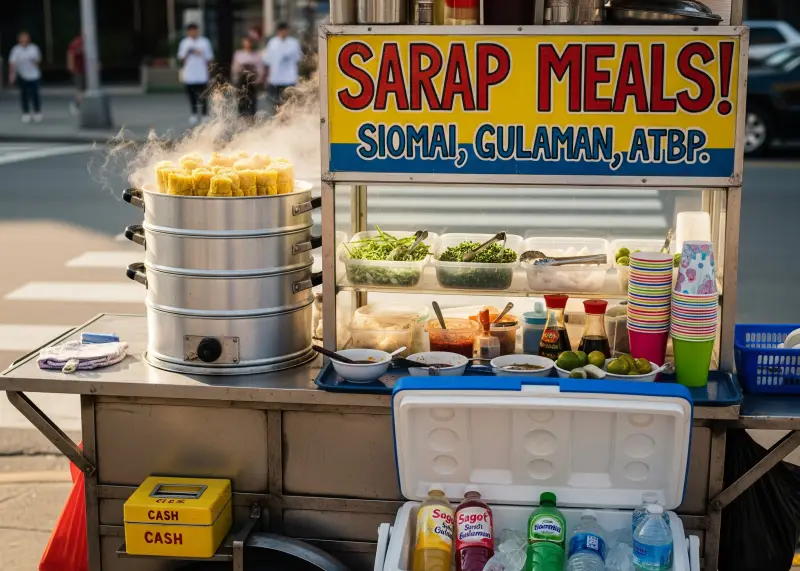abouStarting a food cart business in the Philippines is one of the most popular and accessible ventures for aspiring entrepreneurs. From the sizzle of fish balls on a busy street corner to the sweet aroma of freshly made waffles in a mall, these small but mighty businesses are a cornerstone of our vibrant food culture. They represent a powerful opportunity for Filipinos to become their own boss, share a passion for food, and achieve financial independence with a relatively low initial investment.
But turning this dream into a profitable reality requires more than just a great recipe. Success in the competitive world of food carts demands careful planning, a solid understanding of the market, and a clear, step-by-step approach. This guide provides a comprehensive roadmap for anyone ready to start a food cart business, covering everything from developing your big idea to navigating the necessary paperwork and launching successfully.

Step 1: The “Bakit” – Finding Your Big Idea
Before you even think about permits or suppliers, you need to answer the most important question: Bakit ito? (Why this?) Your concept is the heart and soul of your business. The most successful carts are born from passion and a unique selling point that makes them stand out in a crowd.
Find Your Niche
Don’t just sell what everyone else is selling. Think about what makes your product special.
- A Family Recipe: A secret family recipe for lumpia, empanada, or even a unique sauce can be a gold mine.
- A Modern Twist: Take a classic street food and give it a modern, “Instagrammable” twist. Think ube-cheese pandesal, gourmet fish balls, or Korean-style corn dogs.
- A Healthy Alternative: Many people are looking for healthier options. A cart offering fresh fruit shakes, granola bowls, or salads can cater to this growing market.
- A Hyper-Specific Craving: Instead of just “burgers,” consider “Angus beef burgers” or “chicken-adobo burgers.” Specialization creates a stronger, more memorable brand identity.
Do Your Research (Mag-imbestiga)
Once you have an idea, it’s time to do your homework. Spend a weekend in your target area. What are people eating? What’s missing? Who are your competitors? How much are they charging? This initial research is crucial and will save you a lot of guesswork later on.

Step 2: The “Paano” – Creating Your Business Plan
A business plan sounds intimidating, but it’s really just your roadmap to success. It doesn’t have to be a 100-page document. A simple notebook where you honestly answer the tough questions is a great start. This is where you figure out the paano (the how).
Franchise or Go Independent?
This is one of the first major decisions you’ll make. A franchise offers a ready-made system and brand recognition, while building your own offers complete freedom. Both paths can lead to success, but they are very different.
| Factor | Food Cart Franchise | Independent (Build Your Own) |
|---|---|---|
| Initial Cost | Higher (₱150k – ₱500k+) but includes cart, training, initial supplies. | Lower (₱30k – ₱150k) but you source everything yourself. |
| Branding | Instant brand recognition and marketing support. | You build your brand from scratch. |
| Operations | Proven, standardized system. Less guesswork. | Complete freedom to innovate and change your menu. |
| Profit Margin | Lower, due to franchise fees and royalties. | Higher, as all profits are yours. |
| Support | Ongoing support and training from the franchisor. | You are on your own; success depends entirely on you. |
Calculate Your Costs
You need to know your numbers. Be realistic and list everything you’ll need to spend on before you make your first sale.
- One-Time Costs: The cart itself, cooking equipment, permits and licenses, initial branding (logo, signage).
- Ongoing Costs: Raw ingredients, packaging (cups, wrappers), rent for your location (if applicable), your salary, and a small emergency fund.

Step 3: The Paperwork – Making It Legit
This is the part no one enjoys, but it is absolutely non-negotiable. Operating legally protects you, your business, and your customers. It builds trust and allows you to operate in better, higher-traffic locations.
Key Permits and Registrations
The requirements can vary slightly depending on your city or municipality, but here are the essentials you will almost certainly need for your small business idea in the Philippines:
- DTI Business Name Registration: For sole proprietors, this gives you the legal right to use your business name. You can even do this online.
- Barangay Clearance: You’ll need this from the barangay where your business will be located. It’s usually the first step.
- Mayor’s Permit / Business Permit: This is the main license to operate from your local city or municipal hall. You’ll typically need your DTI and Barangay Clearance to apply for this.
- Sanitary Permit: From the local health office. They will inspect your cart and processes to ensure you meet food safety standards. Your staff will also likely need health certificates.
- Bureau of Internal Revenue (BIR) Registration: To get your Tax Identification Number (TIN) and the authority to print official receipts.
Don’t be intimidated. Go to your local municipal hall, and they usually have a “Business One-Stop Shop” that can guide you through the process.

Step 4: The “Gamit” – Your Cart and Supplies
Your food cart is your store, your kitchen, and your biggest advertisement all in one. It needs to be functional, durable, and eye-catching.
Designing Your Cart
Whether you’re buying a pre-made cart or having one custom-built, think about workflow. Where will you cook? How about the ingredients? And where will you serve customers? It should be easy for you to move around and easy for customers to order from. Your branding-your logo and business name-should be clear and easy to read from a distance.
Sourcing Equipment and Ingredients
Find reliable suppliers. For equipment, look for stainless steel as it’s durable and easy to clean. For your ingredients, building a good relationship with a supplier at the local market (palengke) can get you better prices and fresher produce. Consistency is key, so make sure you can get the same quality ingredients every single day.

Step 5: The “Pwesto” – Location, Location, Location
A great location can make or break your business. A cart with mediocre food can thrive in a high-traffic area, while a cart with amazing food can fail if no one can find it.
Finding the Perfect Spot
Look for high foot traffic. The best spots are often:
- Near schools and universities
- Outside office buildings
- At transport terminals (bus, jeepney, tricycle)
- In or near public markets
- Inside malls (though rent is much higher)
Spend a day observing your potential spot. Are the people passing by your target customers? Is there too much competition? Is it safe and well-lit, especially if you plan to operate at night?

Step 6: The “Simula” – Your Launch and Marketing
You’re ready! Now it’s time to let people know you exist. You don’t need a huge marketing budget to make a big impact.
Marketing on a Budget
- Social Media is Your Best Friend: Create a Facebook or Instagram page. Post high-quality, delicious-looking photos of your food. Announce your opening day, your location, and any promos.
- A Great Signage: Your cart’s signage is your 24/7 advertisement. Make it big, bold, and appetizing.
- Introductory Promo: Offer a “buy one, get one” deal or a discount for your first week to attract initial customers.
- Free Samples (Patikim): Never underestimate the power of a free taste. If your food is delicious, a small sample is often all it takes to convince someone to buy.
📌 Frequently Asked Questions
1. How much capital do I really need to start? It varies widely. A simple, independent cart with basic equipment could start for as low as ₱30,000 – ₱50,000. A more complex cart or a popular franchise could require ₱150,000 to ₱300,000 or more.
2. Is a food cart business really profitable? It absolutely can be. The key is managing your food costs and having a good location. Because your overhead is low compared to a restaurant, your profit margins on each item sold can be quite high.
3. What is the most common mistake new food cart owners make? A common mistake is not knowing the numbers. Failing to accurately track daily costs and sales makes it impossible to know if the business is truly profitable. The second is choosing a poor location.
4. How many items should I have on my menu? Start small and focused. It’s better to do 3-5 items perfectly than 10 items poorly. A limited menu reduces waste, simplifies your operations, and helps you build a reputation for your specialty.
5. Do I need to have cooking experience? It definitely helps, but passion and a willingness to learn are more important. You need to be able to consistently produce a delicious and safe product. Practice your recipes until you can make them perfectly every time.
Your Journey Begins Here
Starting a food cart business is not easy, but it is deeply rewarding. It’s a journey that requires planning, hard work, and a whole lot of heart. From my own experience traveling the country and speaking with countless small business owners, I can tell you that every successful entrepreneur started with a single step. They had an idea, they made a plan, and they had the courage to begin.
This is your chance to be your own boss, to share your passion for food, and to build a future on your own terms. So, do your research, create your plan, and get ready to start your engine. The road to success is waiting.










